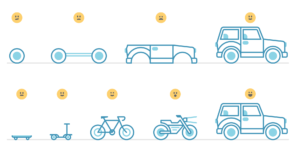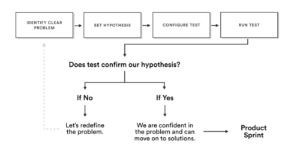Is Minimum Viable Product the Best MVP? We Think Otherwise.
We’re shifting from minimum viable product to maximum value product.
What is a Minimum Viable Product?
Despite its name, a minimum viable product is not a product. It’s a technique used for efficient, effective product development.
A minimum viable product:
- Is market-ready
- Comprised of basic features
- Has enough value to attract and retain users
- Is constantly updating based on feedback
There’s a reason it’s called a minimum viable product — an MVP is the minimum version of a product. It’s not a prototype, because it’s functional and ready-for-use. It’s not a finished product, because it’s still undergoing iterations based on feedback.
Picture a basic messenger app. The minimum viable product version of a messenger app enables communication by letting users send and receive text-based messages. Nothing more, nothing less.
Over time, communication can be enhanced by adding the ability to send images, animated gifs, and audio messages. Maybe the platform will let users react to each other’s messages with emoticons. These features aren’t necessary for communication, but they make the experience better.
The minimum viable product takes that base messenger app and upgrades it based on user-requested or team-researched features.

How Do You Get to Minimum Viable Product?
There’s a process to defining a minimum viable product. Various stages of research and development are required before something can be considered a minimum viable product.
- Identify what problem your product solves.
- Research the industry.
- Research your target audience(s).
- Identify your product’s basic features — and differentiators.
- Map out different areas of potential product growth.
- Identify risks and opportunities.
We know that there’s nothing more exciting than that “Aha!” moment when you figure out an idea for a great product, but make sure you plan for the journey ahead before rushing into development.
Launch vs Release
Your minimum viable product is ready for its first rounds of testing. What next?
Know the difference between product launch and product release.
Product Launch – The first initial release of a product (Product 1.0)
Product Release – An updated version of a product (Product 1.2)
If you are launching your product live for the first time, make sure you correctly label your launch as a launch. When you make improvements or add new features, label those newer versions as releases.
Why Should You Use Minimum Viable Product?
Companies seeking an open-ended, efficient product release should use a minimum viable product. MVP can be applied anywhere, from physical items to digital apps.
Minimum viable product promises:
- Faster Product Release
- Safer Launch
- Maximized Product Value
Once you’ve captured an audience with your concept, you’ll want to deliver a product before they move on.
Before developing a minimum viable product, businesses should support their idea with:
- Market research
- Price Modeling
- Concept validation
Minimum viable product keeps product development on track and delivers consistent results. Launching a product with fast, reliable updates may also help attract investors that work with early-stage products.
We want to note that a faster product launch does not equate to rushed development. A minimum viable product is simply an efficient way to build and test a product. Although it delivers a minimum product, an MVP should not be half-baked.
Minimum viable product must still deliver both function and value. Many businesses make the mistake of treating minimum viable product as a period for QA testing.
Ensure that your product:
- Is as bug-free as possible
- Does not contain unfinished features
User Feedback
The minimum product delivers a highly-focused product that speaks directly to your user’s needs. One reason why product teams find so much success in MVP is because of its heavy reliance on user feedback.
Similar to data-driven design, minimum viable product incorporates real-time user feedback throughout the process.
Feedback is crucial during every stage of a product’s lifecycle, including:
- Feature development
- Asset design
- User flow
- Style
- Color scheme
- Layout
Constantly engage with early users to find out what features they like and what features need work. User feedback combined with short development cycles is a great way to grow and improve a digital product.
Maximum Value Product
At Jakt, we take a slightly different approach to product development. While we see the value in minimum viable product, we also want to deliver the best experience to every one of our partners. We find the most success using the other MVP, maximum value product.
What is Maximum Value Product?
Maximum value product is as much as a product development technique as it is a product.
Our MVP, maximum value product, is a product that provides the maximum value to its users given the constraints placed upon it.
We define constraints as:
- Time
- Budget
- Project scope
These factors aren’t static. They can -and usually do- change as we work with our partners to plan, build, and scale their digital products.
Maximum value product focuses on validating a problem, then solving that problem.
Over 70% of startups die every year because the market has no need for their product.
There are countless apps out there that are great at what they do. But, when you take a market-perspective, how many messenger apps do we need? Maximum value product validates product investment by determining market need.

Why use a Maximum Value Product?
Maximum value product helps you understand a problem at a root level. Do people want a new messenger app, or do they want a better way to connect with new, like-minded people?
Businesses that want to validate solutions, rather than problems, should take a maximum value product approach.
Uncovering the Problem
Before you can dive into the maximum value product, you must first uncover the problem. Designing a product to solve a specific problem confirms that your product has value.
First, ask yourself these questions:
- What problem does this product solve?
- What audiences have this problem?
- Why is it a problem?
- How big of a problem is it?
- How do users currently solve the problem?
- Is anyone else working to solve the problem?
- Why are other solutions not properly addressing the problem?
If any of these questions threaten to nullify the purpose or design of your product, it’s worth circling back and identifying new areas of opportunity.
More often than not, product ideas that run through these questions do fail at first. It’s normal to run through several idea iterations before a product goes into development.
Maximum value product, as its name suggests, ensures your product delivers maximum value by challenging its scope and purpose.
Creating a Maximum Value Product
Similar to minimum viable product, there’s a process to building a successful maximum value product. Once the fundamental market problems are fleshed out, the next step is to figure out if your product is worth the investment.
- Is the solution valuable enough that customers will pay for the product?
- Is your solution profitable?
This is where the budget constraint that we mentioned comes into play. Maximum value product seeks to create something with the highest possible value — within budget.
Research is important in any design process and maximum value products are no different. User research and interaction are necessary to test a product’s usability. From there, adjustments can be made based on user flow and sentiment.
We outlined 7 steps to create a maximum valuable product:
- Collect user feedback on the product idea.
- Conduct ethnographic research.
- Research competitor offers.
- Research market risks and opportunities.
- Prototype the product.
- Test the product with actual users.
- Reiterate your product based on user feedback.
Agile and MVP
Agile project management goes hand-in-hand with maximum value product.
When you think about any product, they’re constantly evolving. From websites to voice apps, developers don’t stop at product launch. They add features, trim bloat, or rework designs.
Agile allows for constant, open communication through the use of sprints. A sprint is a short iteration cycle that focuses on completing a short-term goal.
Remember the purpose of maximum value product: value.
It’s all too common to find products that are released even if they lack crucial features. Rapid product releases run the risk of dissatisfying users by delivering broken features.
Focused internal sprints can ensure all product deliverables are completed quickly and at the quality levels your users expect.
You can segment MVP sprints into three broad categories:
- Problem Sprints
- Product Sprints
- Business Sprints
By tackling each aspect in sprints, you can determine the best way to create your maximum value product. You also can quickly determine if the creation of your product is possible given the MVP’s constraints.
Segmenting out your sprints also helps your team members efficiently collaborate by focusing on the goal laid out before them. Say goodbye to scrambled projects and hello to your highly focused MVP.
Processes directly correlate to the success of a maximum value product. Here are the sprints our teams make when working with partner products:
- Define
- Solution
- Branding
- Design
- Development
- Iteration
Depending on the product, your sprint structure may differ. Remember that each sprint should receive a healthy dose of research and user feedback.
If you have a great product idea and want to maximize its impact, get in touch — we’d love to learn more about your project.

0 Comments